#nerva antonine
Explore tagged Tumblr posts
Text

Roman Emperors: Augustus – Gordian I
27 BC – 238 AD
Excited to be working on these again! The series is nearing completion! Pride edition will follow shortly…
#roman emperor#roman empire#rome#history art#ancient rome#1st century bc#1st century#2nd century#3rd century#julio claudian dynasty#augustus#caligula#emperor nero#flavian dynasty#domitian#nerva antonine#marcus aurelius#trajan#hadrian#commodus#geta#caracalla#severan dynasty#elagabalus#digital art#roman tag
67 notes
·
View notes
Text
Hadrian, of course, is one of the most controversial Emperors other than Constantine:
Out of all the Roman Emperors Hadrian is one of those who has left one of the most directly contemporary presences in the world today. This is because of two wars that occurred during his reign involving the Judean ethnos and the Roman state. The first was when he was heir to the Emperor Trajan, held as the model Roman Emperor, and depopulated parts of the islands of the Mediterranean and North Africa in a gruesome bloodbath that derailed Trajan's plans to extend Roman power far to the east.
The second was at the end of his reign and largely followed from the consequences of the first. Hadrian was an unconventional Emperor, he can in a sense be held to be the first Byzantine Emperor as he was very self-consciously Greek, sought to Hellenize the entire region (which is what touched off the Egyptian and Jewish revolts of his reign) of Eastern Rome and to Hellenize Rome and the Western Empire itself. He also adopted a very Chinese-style policy of All Under Heaven bowing before the First Citizen of the Empire, while erecting walls to mark what was within the imperium and what was beyond it.
In his lifetime the legacies of his predecessor were enough that the faults didn't start creaking through and they largely avoided doing so under Antoninus Pius as well. And then with the reign of his second successor, Marcus Aurelius, the crises restarted and slowly escalated into the Military Anarchy. And of course in his own lifetime the effort to refound the city of Jerusalem as Aelia Capitolina and to erect a temple of Zeus on the Temple Mount touched off the Bar Kochba revolt in which a third of the Roman Army waged a genocidal war against the Jewish people, marking the final end of the Second Temple era and of the Jewish presence in Eretz Yisrael as the majority of its inhabitants for almost 2,000 years afterward.
Hadrian would have been very surprised that it was this one war against a troublesome group in the east that was his main legacy to the future and not his revival of the Augustan policy on not expanding the Empire, and still more surprised (if dubiously pleased) that the Greek version of Rome he so esteemed would outlast the pagan one he led for another thousand years as the medieval 'Byzantine' state.
9/10.
#lightdancer comments on history#book reviews#nerva-antonine dynasty#hadrian#european history#roman empire
3 notes
·
View notes
Text

Portrait of Emperor Domitian (r. 81-96) at the Louvre. He was the younger brother of the beloved Titus who only ruled for a brief period. This last emperor of the Flavian dynasty ultimately met his demise through his arrogant dismissal of the Senate's authority and his tyrannical pretensions, ordering his subjects to call him "dominus et deus" (master and god). Senators, who held the highest positions in the empire, started to boycott the regime, withdrawing from public life. Most of them were inspired by Stoicism, leading the increasingly paranoid princeps to prosecute Stoic philosophers. Domitian was eventually killed in a coup which saw the rise to power of the old Nerva, whose reign ushered in the golden age of Rome under the Antonine rulers.
#roman#roman art#roman history#ancient rome#roman empire#flavian dynasty#domitian#rome#ancient art#sculpture
56 notes
·
View notes
Text

A ROMAN MARBLE PORTRAIT BUST OF THE EMPEROR LUCIUS VERUS ANTONINE PERIOD, LATE 2ND CENTURY A.D.
Lucius Aurelius Verus (15 December 130 – January/February 169) was Roman emperor from 161 until his death in 169, alongside his adoptive brother Marcus Aurelius. He was a member of the Nerva–Antonine dynasty. Verus' succession together with Marcus Aurelius marked the first time that the Roman Empire was ruled by more than one emperor simultaneously, an increasingly common occurrence in the later history of the Empire.
Born on 15 December 130, he was the eldest son of Lucius Aelius Caesar, first adopted son and heir to Hadrian. Raised and educated in Rome, he held several political offices prior to taking the throne. After his biological father's death in 138, he was adopted by Antoninus Pius, who was himself adopted by Hadrian. Hadrian died later that year, and Antoninus Pius succeeded to the throne. Antoninus Pius would rule the empire until 161, when he died, and was succeeded by Marcus Aurelius, who later raised his adoptive brother Verus to co-emperor.
As emperor, the majority of his reign was occupied by his direction of the war with Parthia which ended in Roman victory and some territorial gains. In the spring of 168 war broke out in the Danubian border when the Marcomanni invaded the Roman territory. This war would last until 180, but Verus did not see the end of it. In 168, as Verus and Marcus Aurelius returned to Rome from the field, Verus fell ill with symptoms attributed to food poisoning, dying after a few days (169). However, scholars believe that Verus may have been a victim of smallpox, as he died during a widespread epidemic known as the Antonine Plague.
Despite the minor differences between them, Marcus Aurelius grieved the loss of his adoptive brother. He accompanied the body to Rome, where he offered games to honour his memory. After the funeral, the senate declared Verus divine to be worshipped as Divus Verus.
#A ROMAN MARBLE PORTRAIT BUST OF THE EMPEROR LUCIUS VERUS#ANTONINE PERIOD#LATE 2ND CENTURY A.D.#marble#marble bust#ancient artifacts#archeology#archeolgst#history#history news#ancient history#ancient culture#ancient civilizations#ancient rome#roman history#roman empire#roman emperors#roman art
166 notes
·
View notes
Text

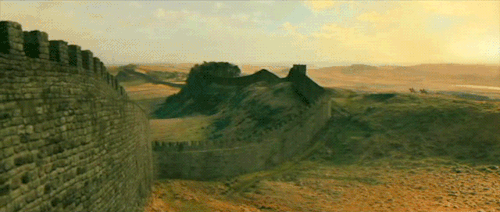
January 24th in the year 76 is the reputed birth date of Publius Aelius Hadrianus the greatest wall builder Scotland can call a friend. 😉
Although now entirely in England it is in what was often called, ‘The debatable land’ the areas around it having changed hands on many occasions, work started on the wall was built in 122AD and stood as the northern frontier of the Roman Empire for over two centuries.
It is thanks to Hadrian’s Wall that the land which became Scotland was first considered one territory. It’s also a fact that we know more about Hadrian than just about every King of the Scots until Malcolm Canmore who reigned almost 1000 years later, and the emperor who in a real sense created Scotland turned out to be a fascinating character.
Hadrian is known as one of the Five Good Emperors, the others being Nerva, Trajan, Antoninus Pius and Marcus Aurelius.
Hadrian’s family were from modern-day Spain and he may have been born there or in Rome in 76, as his father was the cousin of the previous Emperor Trajan, who looked after the boy when Hadrian’s father died when the future emperor was just nine.
I’ll skip the full story of his life and press on with the story of the wall.
Hadrian knew the east of the empire well, but not the far west. He travelled through Gaul to Britain and there he was told of the fierce barbarians to the north, so often portrayed on page and screen as savages, who frequently raided south deep into Roman Britain.
These “barbarians” were most likely the Picts who then occupied most of what is now Scotland.
As someone who commissioned or oversaw the building of bridges, aqueducts and temples and who made the Pantheon the greatest building in Rome – it survives largely intact even now – the solution to the northern problem was simple. He would keep out the barbarians, and thus ordered the construction of a wall right across the “waist” of Britain from Luguvalium to Coria, or Carlisle to Corbridge as we know them.
The story is told that he was informed that it couldn’t be done – Hadrian went to Eboracum (York) and supposedly drew up the first plans himself.
For the first time, the inhabitants of what we know as Scotland knew they had a southern limit – not that it stopped them invading anyway. It was 73 miles long and in places was up to 12 ft high and 20ft wide, with forts and fortlets spread out along the wall. It remains the largest Roman artefact still extant in the world.
So was it really the southern border of Scotland? Never officially called the border, the Wall still marked the extent of the Roman Empire with everything south being Roman Britain, especially after the Antonine Wall between the Clyde and Forth was abandoned only eight years after it was completed in 154. And the Romans did not leave until the 5th century.
So for centuries, everything north of Hadrian’s Wall was seen as the land of the barbarians, and that is why, when the land we know as England was invaded by the Angles, Saxon, Jutes, Danes and Norsemen, the peoples north of the Wall were left to their own devices.
It has been argued that no one has ever really “conquered” Scotland in that the country we think of as Scotland did not really come into being until the Picts and Scots joined together and later took back Strathclyde and the Lothians from the Britons and the Northumbrians respectively – it was only in 1018 that the Battle of Carham finally confirmed the land north of the Tweed on the east coast as part of Scotland. Various English kings claimed “overlordship” of Scotland, but the man who came closest to conquering this land was a commoner, Oliver Cromwell, and even he left alone the far north and the Hebridean islands.
Hadrian died in 138, having defined the limits of the Roman Empire in the West, limits that did not include Scotland, and we should be grateful to him, for it took a man of genius to realise that the people of this land are different from those south of his Wall.
22 notes
·
View notes
Text
Wikipedia article that is only available in Spanish. I translated into English some abstract to share here. I always wanted to write a post about that "Antonine dynasty" fallacy. Luckily I found someone who explains much better

Ulpia-Aelia Dynasty
Ulpia-Aelia Dynasty is the new name proposed by Alicia M. Canto and adopted by a sector of current historiography to refer to the seven emperors of the Roman Empire, from Nerva to Comodo. Specifically includes emperors Trajan, Hadrian, Antoninus Pius, Marcus Aurelius and his co-emperor Lucius Verus.
Doctrinal approaches
Unlike other dynasties such as the Julio-Claudian dynasty, the Flavian dynasty or the Severan dynasty, there is no agreement in Ancient History on how to group and name the emperors of the 2nd century, "the best century in the history of Humanity" according the British historian Edward Gibbon.
The most used definitions from the 18th century until today have been and are "the Antonines", "the Good Emperors" and "the Adoptive Emperors". There were only two Antonine: Marcus Aurelius and Lucius Verus, and both were, above all, two Aelii (from the Aelia family). The adoptions were just a political cosmetic operation, but they did not comply with the ideal principles of adoption described by Galba or Pliny the Younger.
The inappropriateness of these three universal classifications is more evident in the face of the 48 ancient texts that demonstrate that throughout that century there existed an authentic dynasty, of Hispanic origins and roots, whose real link was not the adoptions, but the line of blood and kinship, entrusted to the women of the dynasty, who transmitted the legitimacy to inherit the throne: Pompeia Plotina, Vibia Sabina, Matidia the Younger, and both Annias, the so-called Faustina the Elder and Faustina the Younger, ending in Commodus.
After the elderly Nerva as a necessary introducer, the following six emperors: Trajan, Hadrian, Antoninus Pius, Marcus Aurelius, Lucius Verus and Commodus - externi (foreigners) according to the Roman historian Aurelius Victor - form an authentic lineage.
All this led Maria M. Canto to propose the term "Ulpio-Aelia", "the Ulpii Aelii", to define the true dynasty of Hispanic origin that goes from Trajan to Commodus (98-192 AD). Some ancient authors, such greek historian Herodian, demonstrate that the Romans themselves did see Commodus as a direct descendant of Trajan, katá thêlugonía ("by the maternal line"), that is, through the aforementioned empresses, and as "A fourth generation emperor".
The reason why names such as "the Antonine dynasty" or "the Antonine emperors" have universally triumphed is not found in ancient texts, but in the European historiography of the 17th and 18th centuries, whose arguments in this sense, although they do not find real foundation in the texts, have been so generally accepted until now.
The new proposal has already been accepted by authors such as José María Blázquez, the Italian expert Anna Maria Reggiani, among others, and the definition can be seen integrated even in some university subject programs. Although, without a doubt, two and a half centuries of historiographic tradition is still very decisive in favor of the other definitions in use.
Alicia María Canto y de Gregorio (Havana, April 23, 1949 – Madrid, March 4, 2024), known as Alicia M. Canto, was a Spanish archaeologist and epigrapher. In 2011 she was appointed corresponding academic of the Royal Academy of History.
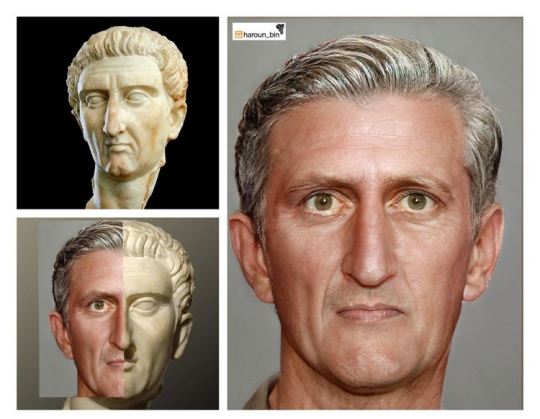
Nerva was chosen just as transitional ruler following the assassination of Emperor Domitian. Except him, the successors of "his dynasty" were related.
I'm really sick of hearing things such "Marcus Aurelius broke tradition by choosing moron Commodus just because he was his son; He made a serious mistake".
None of those emperors were chosen after going through a casting. Trajan's adoptive successor was his nephew, the only male relative he had, plus was married to Trajan's great-niece. Hadrian would have been emperor if Trajan had had a son? Marcus Aurelius and his wife Faustina were descendants of Trajan, he on his father's side and she on his mother's side. Marcus Aurelius did nothing more than continue the true tradition of his family.
Just as Augustus' dynasty is known as the Julio-Claudian, ending with Nero, Trajan's is the Ulpia-Aelia dynasty and ending with Commodus. And in my opinion the term Nerva Antonine dynasty, which I find in all English articles, simply doesn't make sense.
89 notes
·
View notes
Text
RVLES
You must survive for one week.
This takes place in a nonspecific Rome of no particular era.
The participants are the imperial families themselves and their closest confidants, plus you. (So Tiberius spawns in with Sejanus, Hadrian with Antinous, Elagabalus with that gladiator, etc.)
While infighting is allowed and, in many cases, inevitable, all participants will consider your salvation or murder their ultimate objective.
The Praetorian Guard and the mob exist and start off neutral, but can potentially be swayed to one side or the other by a popular or persuasive figure.
The Contrarian Option gets you the five Pre-Severan non-dynastic emperors who actually controlled the city of Rome at some point (Galba, Otho, Vitellius, Pertinax, and Didius Julianus).
52 notes
·
View notes
Photo
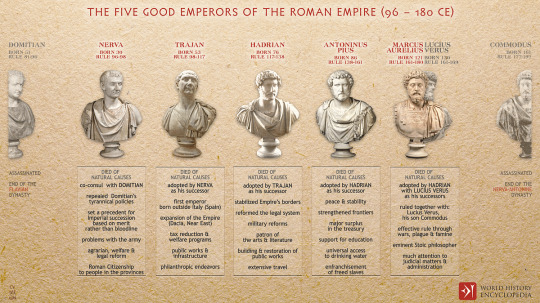
The Five Good Emperors of the Roman Empire (96 - 180 CE)
An infographic illustrating the succession of Roman rulers between 96 and 180 CE, known as the Five Good Emperors (a term unknown to the ancient Romans, coined by Nicolo Machiavelli in his 1531 manuscript Discourses on Livy and made widely popular by Edward Gibbon in his 18th century The History of the Decline and Fall of the Roman Empire,) Nerva, Trajan, Hadrian, Antoninus Pius, and Marcus Aurelius. Those were everyone but two of the Nerva-Antonine Dynasty, with Lucius Verus and Commodus not making the cut. During the time of this “kingdom of gold” (Gibbon), the Roman Empire “was governed by absolute power under the guidance of wisdom and virtue.” (Gibbon) The 84-year period is widely accepted as the high point of the Empire, with Imperial Succession ensured through adoption based on merit and acceptance rather than a strict bloodline.
Image by Simeon Netchev
81 notes
·
View notes
Note
Faggot😀
The Roman Empire at its territorial peak
Between the years 14 and 68 the heirs of Augustus succeeded him: Tiberius, Caligula, Claudius and Nero. This dynastic succession was interrupted when emperor Nero died and a civil war broke out in the year 68. Three emperors fought for power and finally, the war was won by Vespasian, part of the Flavian dynasty.
The Flavian dynasty was succeeded by the Antonines (96 – 193), a generic name given to Nerva, Trajan, Hadrian, Antoninus Pius, Marcus Aurelius and Commodus. These emperors had a very similar policy to the Flavians.
The accession of Septimius Severus (197 - 235) made him the first of the Imperial Severan Dynasty to rule (197 - 235). He was replaced by Caracalla, Macrinus, Elagabalus and Alexander Severus.
The absolute power of Rome, the capital of the Empire, was weakened over time. Between 235 and 300 Rome’s only priority was to defend its borders from the continuous attacks by the Barbarians and from the Sasanians (from Persia). The pressure of these raids prompted the army to assume power in 235. This era is known as the military anarchy and lasted about 50 years. The emperors of this time had one sole purpose: fighting the Empire’s enemies and securing the borders.
As a consequence of these constant wars, the army was very expensive to maintain, and thus the Empire became crippled with debts. This in turn impoverished the population and many lost their identity and values. Many were put in doubt of their religious beliefs, especially with the arrival of new doctrines from the East.
The persecution of an ever-growing Christian minority by Diocletian was a way to rid the empire of the dangers it was facing.
5 notes
·
View notes
Text
Hadrian Sestertius engraved by the "Alphaeus Master"
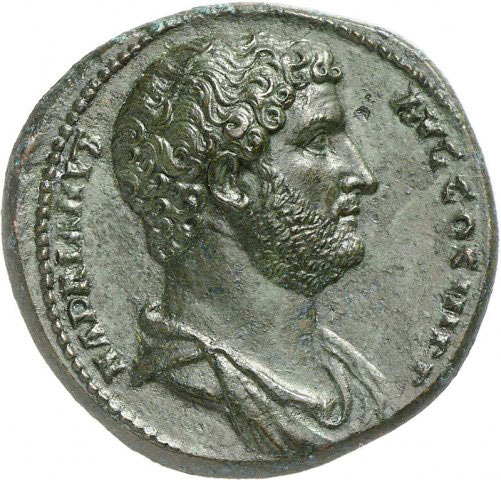
Sestertius of the Emperor Hadrian, struck 132 (?). (i swear to god every time these coins go up for auction these coins have a different date attributed to their striking on the listing). Obverse legend reads "HADRIANVS AVG COS III PP Reverse legend reads "PAX AVG" Among all Roman portraiture of the second century, the coins and medallions attributed to the "Alphaeus Master" stand out as being the best. The engraver is also thought to be a certain "Antoninianos of Aphrodisias" and was possibly a part of Hadrian's inner circle, as Hadrian was a notorious lover of Greek culture.

As far as I know there are only other 4 coins known from these same dies, here are photos of two of the other examples that I was able to find.
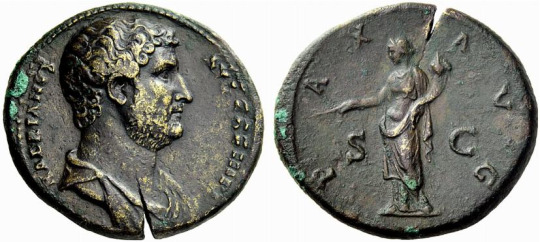
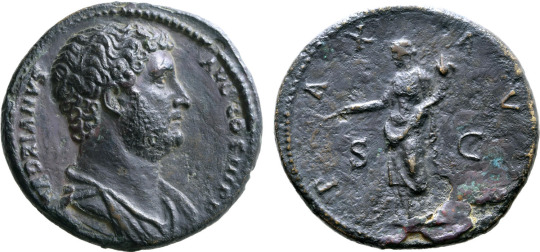
I've taken an interest in the coins attributed to him, and recently been drawing original Sestertii of the other Nerva-Antonine emperors in an attempt to try and replicate the Alphaeus Master's style. I'll be posting those at some point soon.
23 notes
·
View notes
Text
Book of the Day - Meditations
Today’s Book of the Day is Meditations, written by Marcus Aurelius from 161 to 180. Marcus Aurelius was a Roman emperor from 161 to 180 AD and a Stoic philosopher. He was a member of the Nerva–Antonine dynasty, the last of the Five Good Emperors (the others were Nerva, Trajan, Hadrian, Antoninus Pius), and the last emperor of the Pax Romana, an age of relative peace, calm, and stability for the…

View On WordPress
#awareness#Book Of The Day#book recommendation#book review#choices#commitment#grace#Growth#Marcus Aurelius#Meditations#Philosophy#Raffaello Palandri#resilience#responsibility#self development#social commitment#Stoic#Stoicism#virtue#wisdom
34 notes
·
View notes
Text

Roman Emperors pride edition! I just think they’re neat
Augustus — Gordian I
#roman empire#roman emperor#rome#ancient rome#history art#digital art#pride#1st century bc#1st century#2nd century#3rd century#augustus#caligula#nero#emperor nero#julio claudian dynasty#flavian dynasty#domitian#trajan#hadrian#marcus aurelius#commodus#nerva antonine#septimius severus#caracalla#severan dynasty#elagabalus#roman tag
27 notes
·
View notes
Text
'And now we turn as events did for the Empire in that day from a Kingdom of Gold to one of Iron and rust':
There are no topics in some ways more ancient in English Classical history than the idea of a decline of the Roman Empire, the ways in which it worked, and how to explain the ultimate implosion of the Western Empire (usually bereft from having to explain what factors specifically made the West unlike the East which remained completely intact to 1204 and resurrected itself for a few centuries after). This book takes one approach at it by starting with Marcus Aurelius and ending with Theodosius I. In this span of time the Roman Empire, the unified bloc around the Mediterranean + Western Europe up to a border surprisingly close to the English-Scottish border underwent some major transformations.
So too did its neighbors, the Germanic tribes underwent consolidation under larger territorial and military blocs like the Quinquegentiani, the Marcomannic Kingdom becoming more powerful in turn. Parthia was overthrown by the Sassanians, who became a far more formidable enemy of both classical Rome and ultimately its medieval successor which they very narrowly failed to kill entirely.
Ultimately one is left to the reality that the Western Empire did fall and some of the ultimate aspects of that fall were indeed laid by both the waves of migrations of barbarians, which can be compared in certain ways to the impact of the Syrian Civil War in modern time. Not in the sense of being hostile invading armies, but in the sense of relatively small groups of desperate people having a knock-on effect all out of proportion to their numbers and one all too vivid.
Too, one is left with the reality that some historians try to claim that the Crisis of the Third Century was exaggerated, which it may well have been to a point and shaded more by comparison with the overly idealized Five Good Emperors. And yet in looking at the Roman Three Kingdoms and the sequence of bloody coups and short-lived Emperors one cannot with a straight face insist that this doesn't count as a crisis. The state corroded in power and only partially rebuilt itself and in the end lost the entire western half of its territory.
Too, one of the most important shifts was both the consolidation of Christianity as a fully separate religion from the equally co-evolving Rabbinic Judaism on the one hand and its ultimate shift, after the Emperor Constantine I the Great defeated Maximian at the Milvian Bridge, to an imperial religion swollen with the power of the Roman Empire. In this it should be noted that Constantine I was not the first ruler to take such steps, Ashoka Maurya did so a long time before him, and that in this regard Constantine represents a pattern that would recur again with Muhammad and the Caliphate and with the Tang Dynasty deliberately promoting Buddhism in China and the Heian era in Japan.
And if the adoption of state power for Buddhism and Islam is forgivable than the Christian version is not something to be uniquely singled out as an evil or a corruption of society (granted this requires Western white people to actually read about the history of Buddhism and the Asian kingdoms that adopted it which is, to say the least, unlikely even when the Internet allows for a starting point there but). The Gibbons thesis that Christianity killed Rome also fails to account for the longevity of the Eastern half, which held together intact until 1204 and rebounded from major crises, including that one, until Mehmed II broke its power with gunpowder. So, ultimately, Constantine I can be seen without being aware of it as the true father of the Byzantine state and the architect of the first steps to the collapse of the West from larger-scale invasions that broke up any ability to retain the Western Empire as a unified sociopolitical unit.
8/10.
#lightdancer comments on history#book reviews#roman empire#nerva-antonine dynasty#severan dynasty#military anarchy#constantinian dynasty#theodosian dynasty
0 notes
Text

Avidia was a well-connected noble Roman woman. She is among the lesser known members of the ruling Nerva–Antonine dynasty of the Roman Empire.
3 notes
·
View notes
Photo

Roman Bust of Emperor Lucius Verus Second half of the 2nd century AD
Marble over life-size portrait bust of emperor Lucius Verus, wearing a cuirass (breast-plate and back-plate) and a paludamentum (cloak), fastened by a fibula (brooch) on his right shoulder.
H. 99.5 x w. 67.5 cm.
Lucius Aurelius Verus (15 December 130 – January/February 169) was Roman emperor from 161 until his death in 169, alongside his adoptive brother Marcus Aurelius. He was a member of the Nerva-Antonine dynasty. Verus' succession together with Marcus Aurelius marked the first time that the Roman Empire was ruled by more than one emperor simultaneously, an increasingly common occurrence in the later history of the Empire.
Born on 15 December 130, he was the eldest son of Lucius Aelius Caesar, first adopted son and heir to Hadrian. Raised and educated in Rome, he held several political offices prior to taking the throne. After his biological father's death in 138, he was adopted by Antoninus Pius, who was himself adopted by Hadrian. Hadrian died later that year, and Antoninus Pius succeeded to the throne. Antoninus Pius would rule the empire until 161, when he died, and was succeeded by Marcus Aurelius, who later raised his adoptive brother Verus to co-emperor.
As emperor, the majority of his reign was occupied by his direction of the war with Parthia which ended in Roman victory and some territorial gains. After initial involvement in the Marcomannic Wars, he fell ill and died in 169. He was deified by the Roman Senate as the Divine Verus (Divus Verus).
#Emperor Lucius Verus#Roman Bust of Emperor Lucius Verus#Second half of the 2nd century AD#marble#marble bust#marble statue#ancient artifacts#archeology#archeolgst#history#history news#ancient history#ancient culture#ancient civilizations#ancient rome#roman history#roman empire#roman emperor#roman art
48 notes
·
View notes
Text

In 97 AD, Emperor Nerva adopted Marcus Ulpius Traianus, known as Trajan, as his heir due to Nerva’s unpopularity with the military and a revolt by the Praetorian Guard. Trajan was a distinguished general, which made him a favorable choice for securing military support. This adoption marked the beginning of the Nerva–Antonine dynasty, which included five emperors known for their effective governance and prosperity. Trajan later became renowned for expanding the Roman Empire to its greatest territorial extent
Aureus Description: Trajan Pater and Nerva. AD 98-117. (7.02 g,). Rome mint. Struck around AD 112-113. Scripted: IMP TRAIANVS AVG GER DAC P M TR P COS VI P P, laureate, draped, and cuirassed bust right / DIVI • NERVA • ET • TRAIANVS • PAT, laureate bust of Nerva right, slight drapery and bareheaded and draped bust of Trajan the Elder left. #archaeology #history #ancient #art #Caesar #ancienthistory #archaeological #rome #italy #roman_empire #roma #heritage #roman_republic #archaeologylife #Orichalcum #Roman_mythology #italia #medallion #romancoin #romanarcheology #romanancientcoins#aureus #denarius #dupondius #follis #antoninianus #sestertius #fils #alsadeekalsadouk #الصديق_الصدوق
Image copyright: https://www.khm.at/objektdb/detail/1060087
#history#archaeology#photography#greek coins#culture#palestrina#roman coins#travel#sidon saida tyre beirut phoenician الصديق_الصدوق#الصديق_الصدوق#nerva#Trajan
6 notes
·
View notes